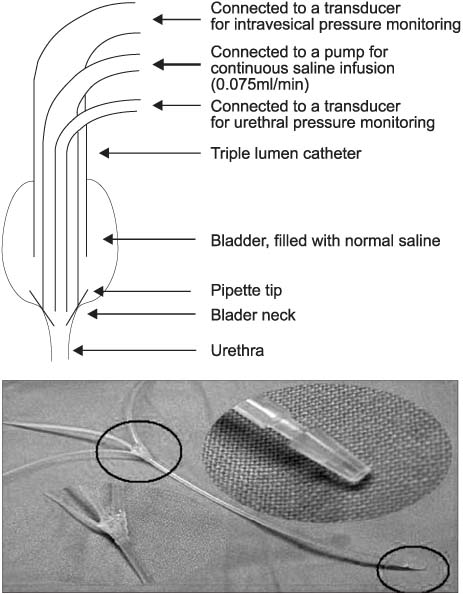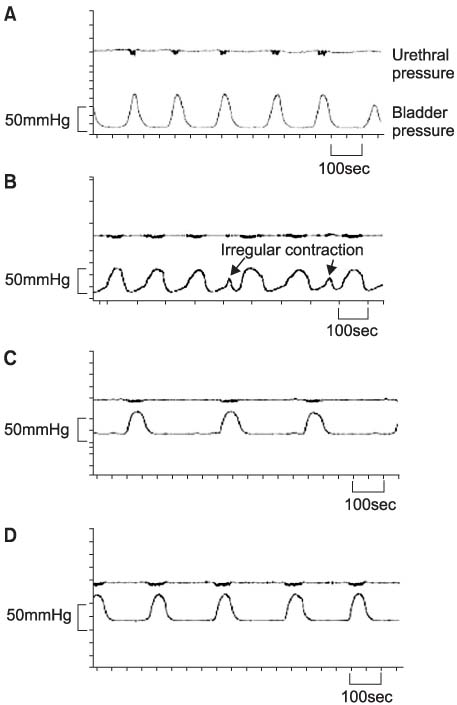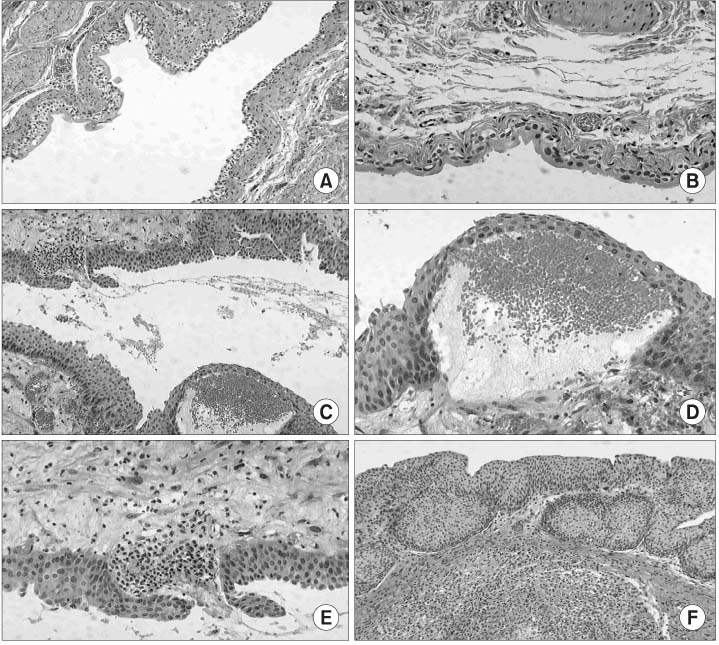Korean J Urol.
2006 Jan;47(1):47-54. 10.4111/kju.2006.47.1.47.
The Effect of Botulinum Toxin and Resiniferatoxin on the Detrusor Overactivity Induced by Cyclophosphamide in Rat Bladder
- Affiliations
-
- 1Department of Urology, Korea University College of Medicine, Seoul, Korea. jeongkl@kumc.or.kr
- 2Department of Urology, Seoul Adventist Hospital, Seoul, Korea.
- KMID: 2294215
- DOI: http://doi.org/10.4111/kju.2006.47.1.47
Abstract
-
PURPOSE: The purpose of this study was to compare the effects of resiniferatoxin (RTX) and botulinum toxin (BTX) on the bladder detrusor function in a cyclophosphamide (CYP)-induced cystitis rat model.
MATERIALS AND METHODS
Sprague-Dawley rats were divided into 5 groups (1: saline treated, 2: CYP and BTX treated, 3: CYP and RTX treated, 4 and 5: CYP treated and sham operated as the counterpart of groups 2 and 3, respectively, with normal saline). 100mg/kg CYP was injected every third day for five weeks. Cystometrograms were performed after the BTX and RTX treatments.
RESULTS
1. The normal control group and the CYP-treated only group. In the CYP-treated group, the time of micturition frequency, the maximal detrusor pressure on the cystometergram (Pvesmax at CMG), the maximal detrusor pressure on the pressure-flow study (Pvesmax at pr/flow) and the episodes of irregular contractions were increased. 2. The CYP-only group and the CYP/BTX or CYP/RTXtreated groups. In the CYP/BTX or CYP/RTX treated groups, the time of micturition frequency, the Pvesmax at CMG, the Pvesmax at pr/flow and the episode of irregular contractions were decreased. 3. The CYP/BTXtreated group and the CYP/ RTXtreated group. There was no statistically significant difference between the two groups regarding micturition frequency, the PvesMax at CMG and the PvesMax at pr/flow, the Dhfo and the episodes of involuntary contractions (p>0.05).
CONCLUSIONS
Intravesical administration of BTX or RTX blocked the CYP-induced detrusor overactivity as was shown by the restoration of the micturition frequency, the intravesical pressure and the involuntary contraction episodes to a control level. There was no statistically significant difference between the two groups regarding the urodynamic parameters.
Keyword
MeSH Terms
Figure
Reference
-
1. Sant GR, LaRock DR. Standard intravesical therapies for interstitial cystitis. Urol Clin North Am. 1994. 21:73–83.2. Birder LA, Kanai AJ, de Groat WC, Kiss S, Nealen ML, Burke NE, et al. Vanilloid receptor expression suggests a sensory role for urinary bladder epithelial cells. Proc Natl Acad Sci USA. 2001. 98:13396–13401.3. Phelan MW, Franks M, Somogyi GT, Yokoyama T, Fraser MO, Lavelle JP, et al. Botulinum toxin urethral sphincter injection to restore bladder emptying in men and woman with voiding dysfunction. J Urol. 2001. 165:1107–1110.4. Smith CP, Franks ME, McNeil BK, Ghosh R, de Groat WC, Chancellor MB, et al. Effect of botulinum toxin A on the autonomic nervous system of the rat lower urinary tract. J Urol. 2003. 169:1896–1900.5. Avelino A, Cruz F, Coimbra A. Intravesical resiniferatoxin desensitizes rat bladder sensory fibers without causing intense noxious excitation: a c-fos study. Eur J Pharmacol. 1999. 378:17–22.6. Lazzeri M, Beneforti P, Spinelli M, Zanollo A, Barbagi G, Turini D. Intravesical resiniferatoxin for the treatment of hypersensitivity disorder: a randomized placebo controlled study. J Urol. 2000. 164:676–679.7. McMahon SB, Abel C. A model for the study of visceral pain states: chronic inflammation of the chronic decerebrate rat urinary bladder by irritant chemicals. Pain. 1987. 28:109–127.8. Berkley KJ, Wood E, Scofield SL, Little M. Behavioral responses to uterine or vaginal distension in the rat. Pain. 1995. 61:121–131.9. Lanteri-Minet M, Bon K, de Pommery J, Michiels JF, Menetrey D. Cyclophosphamide cystitis as a model of visceral pain in rats: model elaboration and spinal structures involved as revealed by the expression of c-Fos and Krox-24 proteins. Exp Brain Res. 1995. 105:220–232.10. Fraiser LH, Kanekal S, Kehrer JP. Cyclophosphamide toxicity. Characterising and avoiding the problem. Drugs. 1991. 42:781–789.11. de Groat WC. A neurologic basis for the overactive bladder. Urology. 1997. 50:36–52.12. Bon K, Lichtensteiger CA, Wilson SG, Mogil JS. Characterization of cyclophosphamide cystitis, a model of viceral and referred pain, in the mouse: species and strain differences. J Urol. 2003. 170:1008–1012.13. Vizzard MA. Up-regulation of pituitary adenylate cyclase-activating polypeptide in urinary bladder pathways after chronic cystitis. J Comp Neurol. 2000. 420:335–348.14. Boucher M, Meen M, Codron JP, Coudore F, Kemeny JL, Eschalier A. Cyclophosphamide-induced cystitis in freely-moving conscious rats: behavioral approach to a new model of visceral pain. J Urol. 2000. 164:203–208.15. Ferguson DR, Kennedy I, Burton TJ. ATP is released from rabbit urinary bladder epithelial cells by hydrostatic pressure changes: a possible sensory mechanism? J Physiol. 1997. 505:503–511.16. Hohenfellner M, Black P, Linn JF, Dahms SE, Thuroff JW. Surgical treatment of interstitial cystitis in women. Int Urogynecol J Pelvic Floor Dysfunct. 2000. 11:113–119.17. Zermann D, Ishigooka M, Schubert J, Schmidt RA. Perisphincteric injection of botulinum toxin type A. A treatment option for patients with chronic prostatic pain? Eur Urol. 2000. 38:393–399.18. Schurch B, Stohrer M, Kramer G, Schmid DM, Gaul G, Hauri D. Botulinum-A toxin for treating detrusor hyperreflexia in spinal cord injured patients: a new alternative to anticholinergic drugs? Preliminary results. J Urol. 2000. 164:692–697.19. Ruda MA, Iadarola MJ, Cohen LV, Young WS 3rd. In situ hybridization histochemistry and immunocytochemistry reveal an increase in spinal dynorphin biosynthesis in a rat model of peripheral inflammation and hyperalgesia. Proc Natl Acad Sci USA. 1988. 85:622–626.20. Anderson KE. Pharmacology of lower urinary tract smooth muscles and penile erectile tissues. Pharmacol Rev. 1993. 45:253–308.21. Magnan A, Bettelini L, Hagan RM, Pietra C. Effects of intrathecal NK-1 and NK-2 antagonists on xylene-induced cystitis in rats. Neuropeptides. 1993. 24:199–200.22. Ishigooka M, Zermann DH, Doggweiler R, Schmit RA, Hashimoto T, Nakada T. Spinal NK1 receptor is upregulated after chronic bladder irritation. Pain. 2001. 93:43–50.23. Dinis P, Charrua A, Arelino A, Cruz F. Intravesical resiniferatoxin decreases spinal c-fos expression and increases bladder volume to reflex micturition in rats with chronic inflamed urinary bladders. BJU Int. 2004. 94:153–157.24. Silva C, Rio ME, Cruz F. Desensitization of bladder sensory fibers by intravesical resiniferatoxin, a capsaicin analog: long-term results for the treatment of detrusor hyperreflexia. Eur Urol. 2000. 38:444–452.
- Full Text Links
- Actions
-
Cited
- CITED
-
- Close
- Share
- Similar articles
-
- Botulinum Toxin in Neurogenic Detrusor Overactivity
- Endoscopic Botulinum Toxin Injection for Refractory Enuresis Based on Urodynamic Assessment
- Clinical application of intravesical botulinum toxin type A for overactive bladder and interstitial cystitis
- The Resininferatoxin Therapy for the Hyperreflexive Neurogenic Bladder: Report of two cases of spinal cord injured patients
- Urologic Applications of Botulium Toxin




